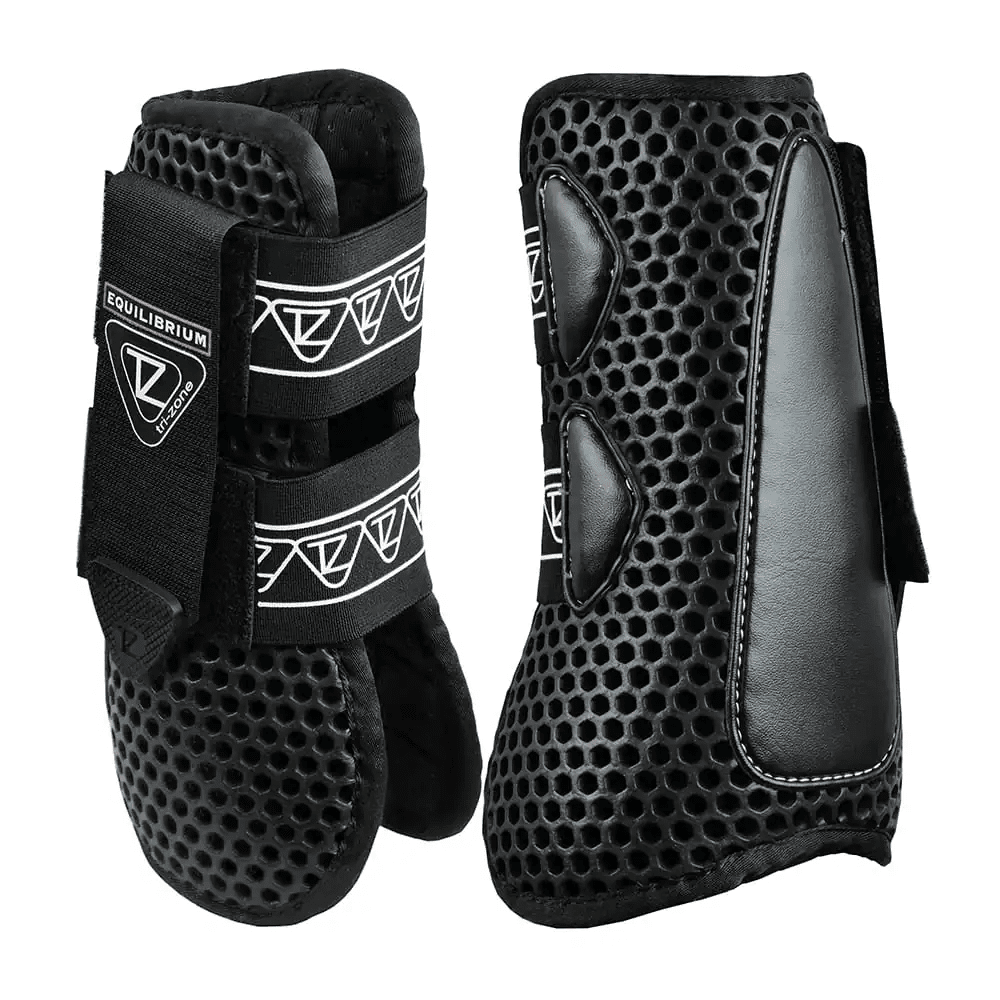1 year product guarantee
Free delivery on most orders over £40
Rated 4.9/5 stars on Feefo

Researched & tested products

Innovating for over 20 years!
Supporting Redwings Horse Sanctuary & Brooke
Feefo Gold Trusted Service Award Winner
Get more time to pay with Klarna
Breathable Boots for Horses
When considering boots for our horses, whether they are tendon boots, brushing boots, schooling boots or cross country boots, most horse owners are now aware that the ‘modern’ horse boot should be breathable, but do we really understand the importance of choosing a breathable boot for our horses?
Firstly we must consider the horse’s leg.
The horse’s leg is made of many bones, joints and muscles with a complex structure of tendons and ligaments that support the weight of the horse’s body.
Because of the workload often put upon them, tendons and ligaments are frequent sites of injury and disease.
What is heat in the leg?
As tendons and ligaments continually extend and contract to allow the horse to move, they create heat as a ‘by-product’. This is a natural process.
However by design, horses tendons operate near failure limits when exercising – there’s a fine balance!
Category
Equilibrium Blog, Horse Care & Equipment, Our Products, WellbeingTemperature and Tendon Damage
Work by Alan Wilson and Allen Goodship (1994) at the University of Bristol showed that the temperature inside the tendons of horses galloping without boots on could reach 45°C. This is only second highest to muscle temperatures. The tendon temperatures are very high not only because of heat production within the tendons, but because they have a relatively poor blood supply, which in any other tissue would help remove heat.
Are these Temperatures of Concern?
In 1997 the same group published the results of a scientific study in which they showed that isolated tendon cells in culture were sensitive to heating.
When the tendon cells were heated for 10 minutes at 45°C, around 10% died, but when they were heated to 48°C for 10 minutes then around 80% died.
These results were also confirmed by a more recent study of equine tendon cells in Japan (Hosaka et al. 2006). This study also showed that the higher the temperature, the more tendon cells that died and that inflammatory mediators were released after heating. Inflammatory mediators are chemicals and hormones within the body that cause inflammation (heat, swelling, pain) and tissue damage. If tendon core (central) temperatures can reach 45°C during a few minutes galloping without boots, it is almost certain that they will get even hotter when boots are being worn.
What happens when you use boots on your horses legs?
The fact that the lower leg gets hot during exercise and even hotter when boots are used presents another potential problem: sweating. When boots are removed the leg underneath is often wet from sweat. When skin is in contact with moisture for a long time it becomes hyper-hydrated; this is the effect you see if you stay in the bath for too long.
Wet skin cannot “breathe” normally, and it becomes more permeable allowing greater absorption of anything on the skin. Wet skin is also more susceptible to mechanical damage, with an increased risk of abrasions and grazing. Finally, wet skin is also more susceptible to bacterial or fungal attack and hence a potentially increased risk of conditions such as mud fever, caused by the bacterium Dermatophilus congolensis.
Considerations:
Many boots claim to be breathable, however some boots are more breathable than others.
Materials and Boot Structure
You may like to ask yourself, do the boots you currently use leave your horse’s legs hot after exercise, are the legs sweaty? Look closely at the materials used next to your horse’s skin. Consider the thickness and padding around the leg. Do they look well ventilated? How do they allow the heat to escape from the leg? Do they have a hard outer shell or rigid panels that cover a large area? You might want to do some research on the materials used within the boot you are using too!
Choose the Right Boot for the Job
Primarily horse boots are worn to protect the horse’s legs from penetration or concussion injuries during exercise or turnout. But do think carefully about wearing the right boot for the activity you are doing. Often a highly protective boot isn’t necessary for low level schooling and will often be bulky and heavy and without allowing the horse’s leg to breathe.
Limit Time on the Leg
It’s important to make sure boots are used only during the period of actual exercise and not left on for long periods when the horse is not active, especially after exercise. Removing boots soon after exercise and cooling the legs is advisable.
Our Standards
When developing our Boots, Wraps and Chaps not only do we source advanced technical fabrics with breathable properties, but we actually test these factors in a laboratory. See our Boot Testing Methods.
Our Tri-Zone Range features brushing boots, all the way to breathable cross country boots. Tested in an independent laboratory to ensure that they are not only providing lightweight, flexible protection, but that they are also importantly, breathable too!
Our Stretch & Flex leg wraps were one of the first ‘breathable boots’ on the market. Made from an actively breathable fabric called Stomatex®, Stretch & Flex are designed to offer comfortable, flexible support for dressage schooling, flatwork and light hacking.
Stomatex® is made of a special type of Neoprene which repels external water, while actively pumping moisture away from the skin through tiny pores in the fabric. Originally developed for human athletes, Stomatex® was designed to provide four-way stretch, to enable use around mobile joints, plus excellent support for active limbs, and an outstanding ability to keep the skin dry, so it could be worn comfortably for many hours.
Conclusion: It is important to choose boots or bandages that allow a good rate of heat loss, and consider the length of time boots and bandages are worn by the horse.
Extracts taken from: The Pros & Cons of Equine Boots by Dr David Marlin www.drdavidmarlin.com
Take a look at our boot range...
View all products-
 Tri-Zone Impact Sports Boots£74.99 – £79.99 View product
Tri-Zone Impact Sports Boots£74.99 – £79.99 View productTri-Zone Impact Sports Boots
High impact horse cross country boots, independently tested protection that…
-
 Tri-Zone Brushing Boots£34.99 View product
Tri-Zone Brushing Boots£34.99 View productTri-Zone Brushing Boots
A great value, super-stylish boot, perfect to use every day…
-
 Tri-Zone Tendon Boots£59.99 View product
Tri-Zone Tendon Boots£59.99 View productTri-Zone Tendon Boots
The Equilibrium Tri-Zone Tendon Boots are a soft shell, yet…
